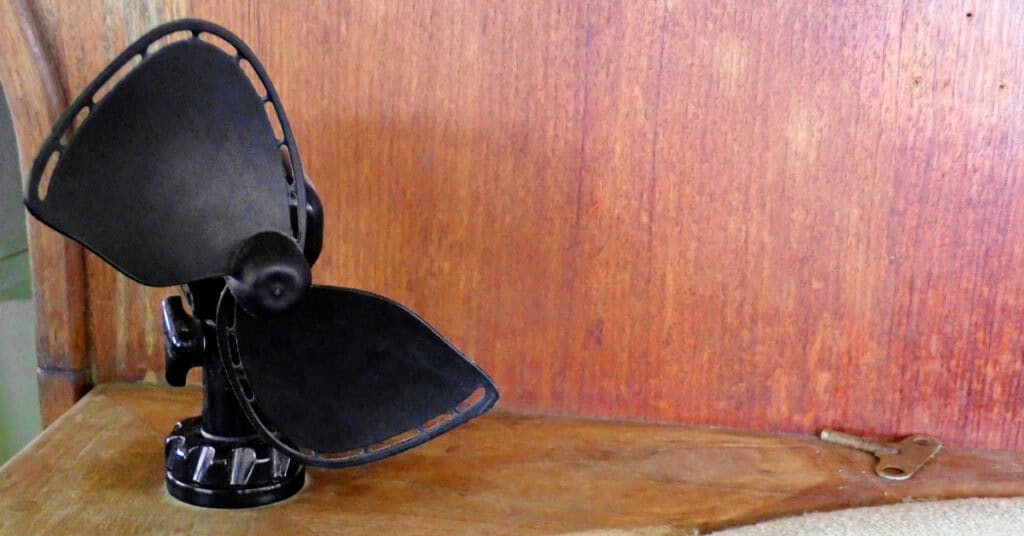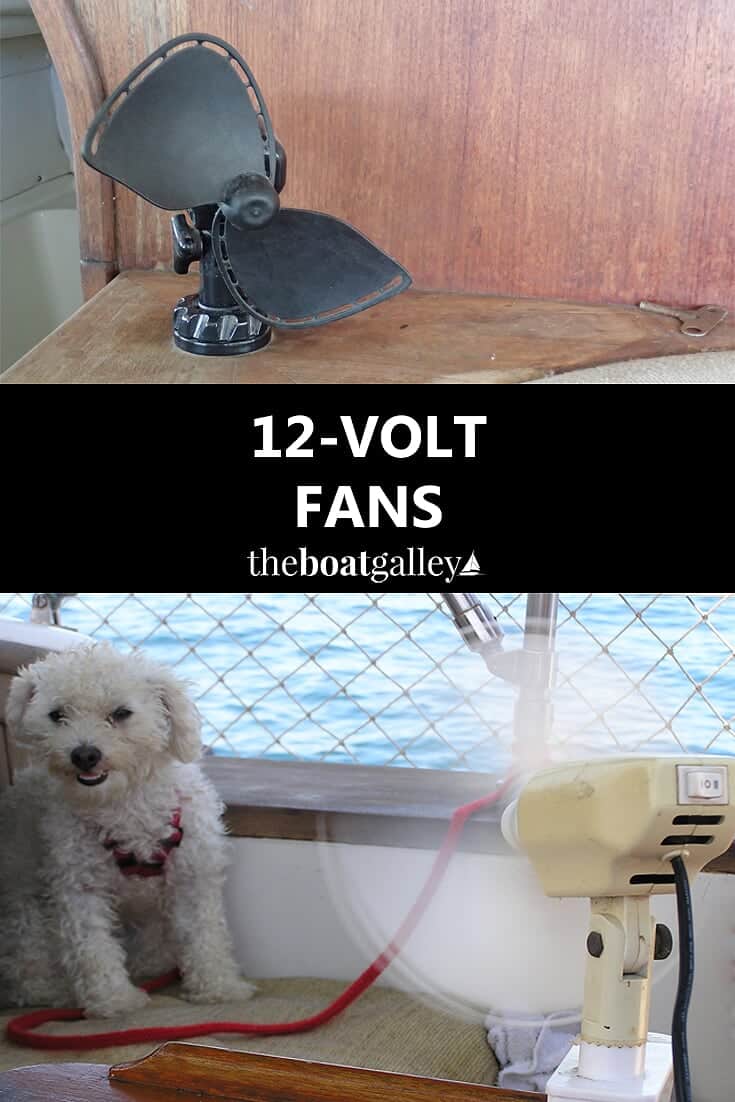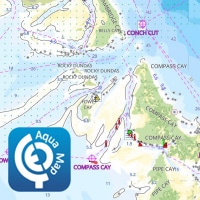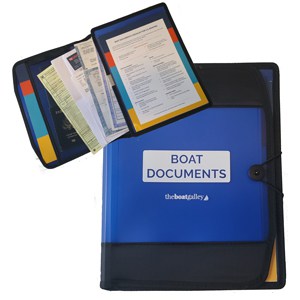Wondering what fans for a boat will keep your galley cool? Having cruised in Baja Mexico, the Caribbean, and the Florida Keys, we’ve given a lot of thought to keeping cool. Next to increasing your ventilation, good fans can make hot temps survivable onboard. Here’s what we learned about 12-volt fans.
Where To Have Fans
You’ll probably want a few more for other areas of the boat, too. We had a total of 8 on board. Well, I should say that we had 8 out in use, plus a couple more as spares. Admittedly, we were in a hot climate. It was often over 95 degrees Fahrenheit with occasional days over 100 cruising the Sea of Cortez in the summer. We put 12-volt fans in the following locations:
- v-berth (2)
- saloon (2)
- head (1)
- galley (1)
- quarterberth (1)
- lazarette (1)
The previous owner had put a couple of Hella fans on board, and we added Caframos. We immediately noticed a HUGE difference in the amount of airflow per amp, which is what I want to pass on here.
Caframo Two-Speed 12-Volt Fan
The Caframo fan pictured above puts out more air per amp used than any other fan. I know that some other fans may spec out that they move more air. But there is a basic design difference that results in more “useful” air flow with this particular model.
The major difference is immediately apparent: there’s no blade guard. With no cage, all the air is directed on you. Don’t worry about safety. The blades are finger-safe, even for children. And yes, I’ve put a hand into one, more than once. It doesn’t hurt any more than knocking on a door hurts. Yes, you notice it, but the blade is soft and stops immediately.
An added bonus is that the fan is much easier to keep clean without a cage!
Manufacturer’s specs say that the fans draw 0.59 amps on high speed. We almost never ran them on high, and they drew about 0.3 amps per our Link 2000.
Installing Caframo Fans on a Boat
The fan comes with a suction cup base, and also a screw-in base. You can also buy an add-on clip base. The suction cups just never worked for us and I don’t know of anyone who used them. Where we wanted the fans permanently mounted (most of them), we used the included screw-in bases (you can still change the angle of the fan, so it’s not a totally fixed position).
Where we wanted to be able to easily move the fans—that would be the two in the saloon area, that we also used at the nav station and in the cockpit—we purchased the clip bases and used them. They’re a bit of a pain to install the first time (holding down a spring and putting a nut on), but not as difficult as many chores on a boat.
The fans come with a 6-foot cord and cigarette-lighter style plug. Where we permanently mounted the fans, we just cut the plug off and hard-wired the fans. They have a High-Low-Off rocker switch on them, so hard wiring does not mean that they are on all the time.
On the clip-mounted movable fans, we used the cigarette lighter plugs and they worked well (if a fan suddenly fails, check the fuse in the plug before assuming the fan is shot).
Maintaining Your Fans
As the fans age, you may notice some vibration and noise. We found it was due to the blade becoming loose or very slightly out of balance. Replacement blades are available for about $6 and it’s a 30-second job (no tools) to replace one. We always kept a few in stock, both for age-related repairs and in case one of us (or something large) fell against a fan and broke the blade.
Out of all the fans we had, the two Caframo fans that we used the most died after about 5 years. The others were still going strong when we sold Que Tal. We replaced a few blades over the course of 6 years—I don’t remember exactly how many, but it did not seem excessive for the use they got.
Caframo says that the fans “create minimal electronic interference” and I’d agree with that—the only interference we noticed was with the SSB/ham radio, and it seemed like everything with a motor (the refrigerator, all fans etc.) interfered with it. We just learned to turn the fans off when we were listening to the net or sending e-mail. The fans did not interfere with the VHF, radar, autopilot or anything else.
NOTE that Caframo now makes a number of different styles of fans, some of which state they draw less than the fan I recommend (as is also the case with the Hella fans, for that matter). However, they all have a cage over the fan blades instead of the soft, safe blades. That cage makes a significant difference in the airflow that actually reaches you—and that’s what I really care about!
Further, I’ve talked to many people who have had a lot of problems with these other (more expensive) models. I don’t recommend them, but I do recommend (and own!) the two-bladed ones that I talk about here.
Sources for the ones that I recommend are the following:
- Caframo Two Speed Compact 12v fan from Amazon
- Caframo Two Speed Compact 12v fan from West Marine
- Caframo Two Speed Compact 12v fans, replacement blades and clip mounts from Downwind Marine (best prices)

Carolyn Shearlock has lived aboard full-time for 17 years, splitting her time between a Tayana 37 monohull and a Gemini 105 catamaran. She’s cruised over 14,000 miles, from Pacific Mexico and Central America to Florida and the Bahamas, gaining firsthand experience with the joys and challenges of life on the water.
Through The Boat Galley, Carolyn has helped thousands of people explore, prepare for, and enjoy life afloat. She shares her expertise as an instructor at Cruisers University, in leading boating publications, and through her bestselling book, The Boat Galley Cookbook. She is passionate about helping others embark on their liveaboard journey—making life on the water simpler, safer, and more enjoyable.
Here’s your “Quick Start” to everything you need to know when living on a boat:











The Boat Galley says
Ventilation in South Florida is a priority!
Carolyn Shearlock says
Congrats! If you’re troubled by no-see-ums, try getting some bridal veil material and using it to cover the hatches. It definitely cuts down on the airflow, but is small enough to keep the no-see-ums out.
Rod Rodgers says
Ok Bill. we get it. you have boat issues consistently.
Carolyn Shearlock says
Test that you’ve got full 12 volts — if the blades are turning but slowly, voltage could be a problem. If that’s not an issue, I’d then think maybe a bad unit and get it replaced under warranty. I’ve only used the ones without a cage and they have always worked really, really well. I know some people with other models have had problems with some being dead out of the box.
Carolyn Shearlock says
I have only used the two-speed Caframo and they have worked very well for us. I’ve heard from others that some of the more expensive models — with more speeds and finger guards, etc. — don’t work as well.
Carolyn Shearlock says
Sometimes the wires run behind the headliner, other times under the floor or along the hull in lockers. When you start looking, you’ll find the existing ones. You really should run the wire from the electrical panel (on an existing breaker or perhaps a bus bar) and not directlty from the batteries. If you’re not familiar with 12 volt wiring, get a copy of Don Casey’s book — it’s great if you’re just learning. Nigel Calder is also good, but assumes that you already know quite a bit. Don Casey’s Sailboat Electrics Simplified on Amazon or Don Casey’s Complete Illustrated Sailboat Maintenance Manual (contains the electrics book in its entirety plus 5 other good reference books). We have the second and use it frequently!
Carolyn Shearlock says
I don’t have one, and the owner’s manual does not say (helpful, huh?). I’d call Caframo at 800-567-3556 or via email (see their contact page).
Kevin Leonard says
You have the positive & negative reversed, so the fan is sucking and not blowing. Reverse the connections, that should correct your issue.
Carolyn Shearlock says
Just wipe the blades off. Actually, I’d remove the blade every 2 or 3 months so that I could really clean it, then put it back on.